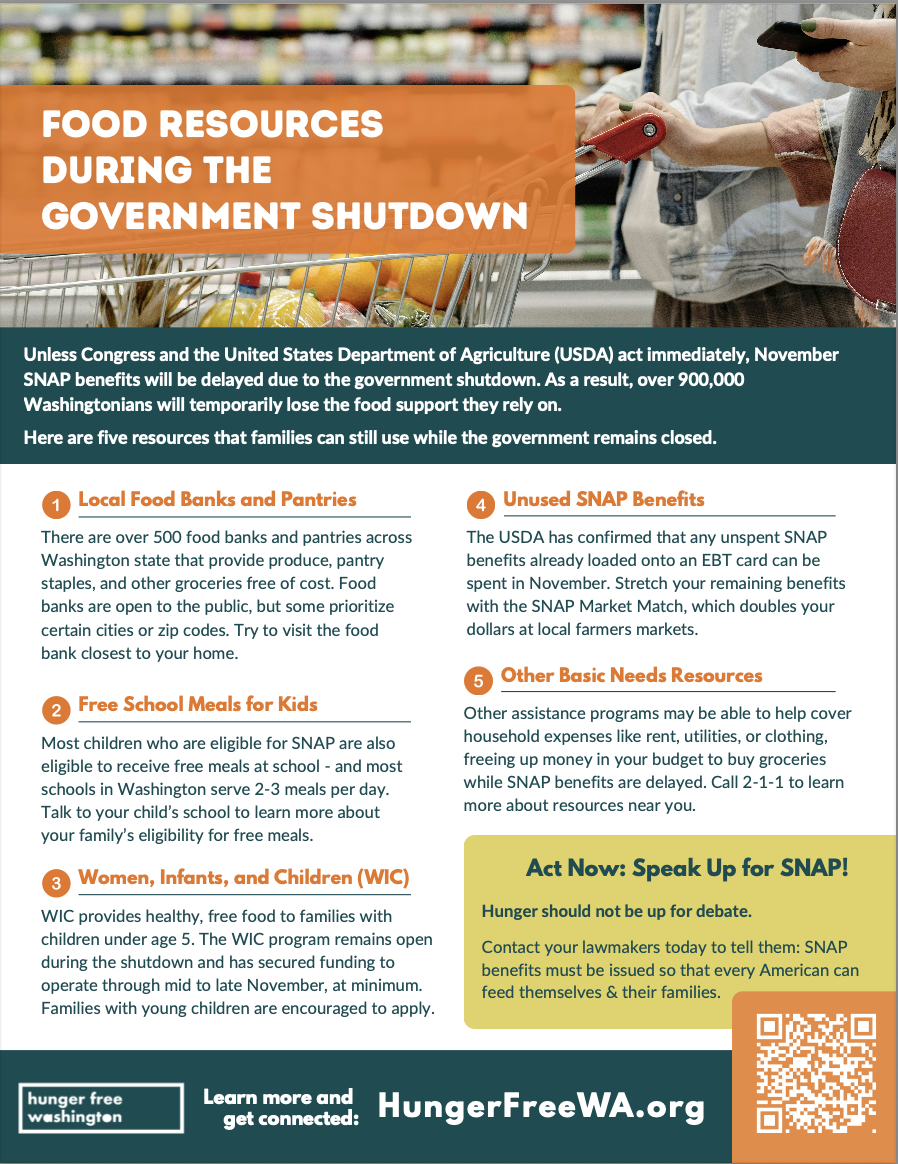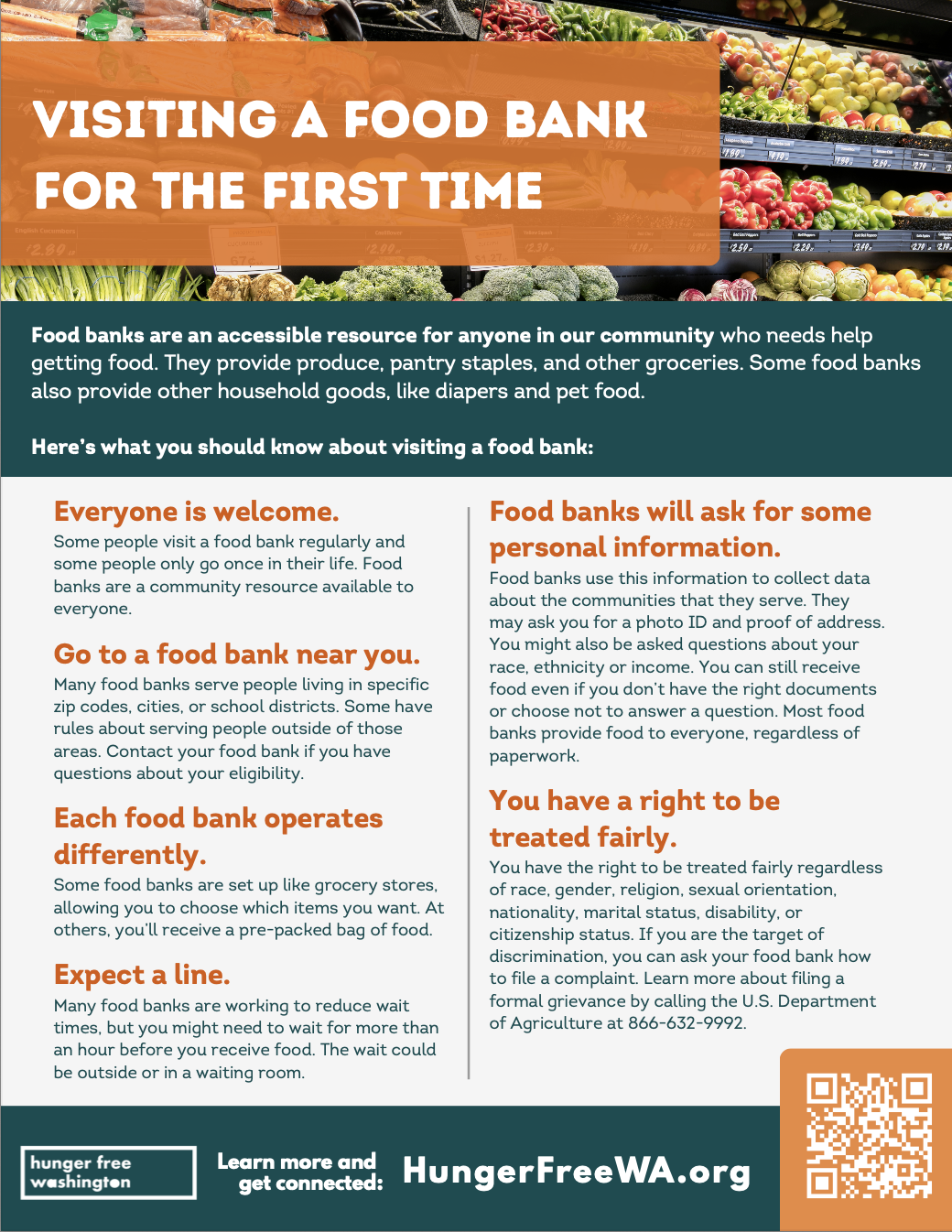Partner Resources
Government Shutdown Partner Resources
The federal government shutdown is impacting people across the United States.
Congress failed to pass a budget before its October 1st deadline, causing a lapse in funding for federal agencies. This is the result of partisan disagreements over spending priorities, including a fight over affordable healthcare. Without a new budget bill, federal agencies must shut down non-essential operations.
Latest update: On November 12th, Congress passed a bill to fund the government and end the shutdown. As federal agencies reopen, food benefits will return to normal operations.
These resources are intended for community organizations. If you are an individual seeking help, please visit our food resources page.
Jump to: Program Impacts | Resources for Families
Impacts to Federal Nutrition Programs
SNAP (Supplemental Nutrition Assistance Program)
Each month, SNAP helps to cover food costs for over 900,000 people in Washington, with an average household benefit of $322. With benefits delayed, families on SNAP will face significant hardship keeping food on the table.
Here’s the latest:
On November 12th, Congress passed a bill to fund the government and end the shutdown. Included in this bill is a guarantee of SNAP funding for the current fiscal year.
In Washington, SNAP benefits are being loaded in full as usual. Households can check their EBT balance by using the ebtEDGE or MyWABenefits apps, or by calling the phone number on the back of their EBT cards.
DSHS is processing new applications for food benefits that were submitted after Oct. 16, 2025, as quickly as possible. Washingtonians should keep applying, renewing and reporting any changes that might affect their benefits, which will help make sure they get any benefits they’re entitled to as soon as possible.
Previous Updates:
On November 7, the Supreme Court temporarily paused a lower court’s order that required the Trump administration to fully fund SNAP benefits in November.
Before this ruling was issued, states across the country, including Washington, began loading November benefits onto EBT cards.
In Washington, SNAP benefits are loaded onto EBT cards between the 1st and 20th of each month. According to Washington’s Department of Social and Health Services (DSHS), households that normally receive their monthly benefits on November 1st to November 7th have already received their full SNAP benefits for the month. This includes more than 250,000 households across Washington.
The impacts of the Supreme Court ruling are still unclear. This type of situation has never happened before. It may take time before DSHS can share additional information about the impacts on families who have already received full November SNAP benefits.
Other things to know:
SNAP users can still spend their unused October benefits. SNAP retailers will continue to accept EBT payments, and EBT cards will continue to work at grocery stores, supermarkets, convenience store, farmers markets, and other retailers that accept EBT.
The SNAP application remains open. If someone believes that they are eligible for SNAP, they should still apply for the program — even during the government shutdown. When the government reopens, retroactive benefits will be issued. Benefits will be backdated to the date that the household’s SNAP application was approved.
Note: In Washington state, Basic Food includes both the federal SNAP program and the state-funded Food Assistance Program (FAP) for eligible non-citizens. Once SNAP benefits resume, guidance for FAP participants may differ.
Follow the Department of Social and Health Services (DSHS) webpage for official communication about SNAP benefits.
Other Federal Nutrition Programs
Other federal nutrition assistance programs remain largely operational. WIC benefits are currently funded through early December. School meal programs continue to serve students as usual, though reimbursements to school districts may be delayed if the shutdown continues. Federal emergency food programs, including TEFAP, continue to fulfill pre-existing orders to food banks. These programs may be threatened if the shutdown continues beyond mid-November. For information about a specific program, visit our main Government Shutdown page.
Resources for Families
Hunger Free Washington is maintaining a resource page with alternative food resources for families who are impacted by the government shutdown.
While food banks cannot fill the gaps left by the federal government, they are one of the primary resources that families can turn to during the shutdown. Find a food bank in your community here.
Help families navigate the shutdown. Download and share resource flyers with your community:


